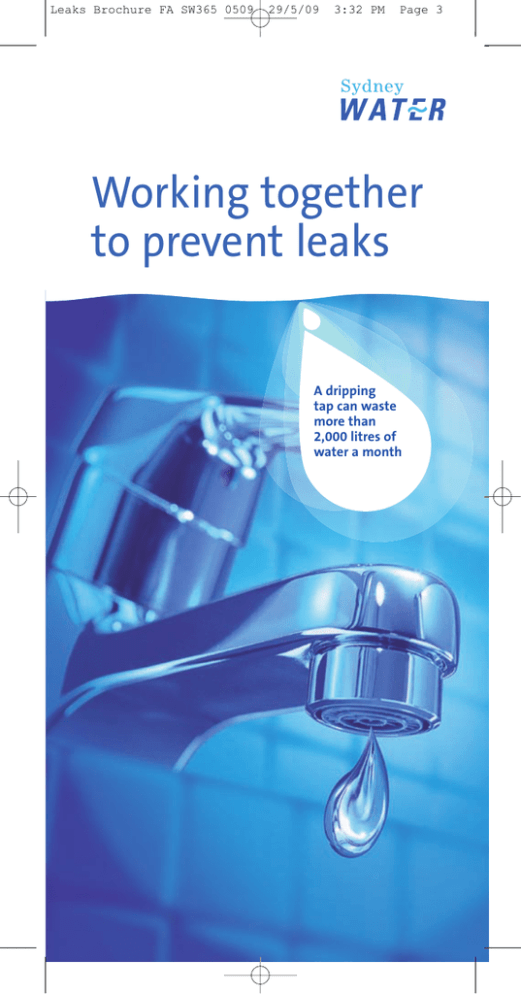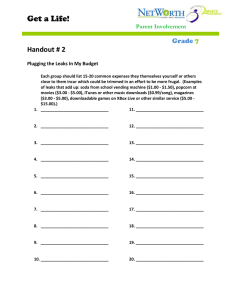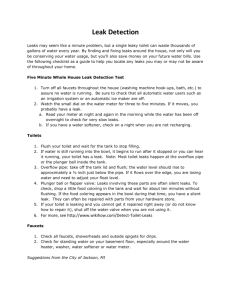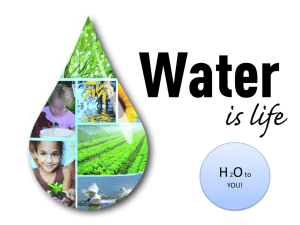Leaks Brochure FINAL
advertisement

Leaks Brochure FA SW365 0509 29/5/09 3:32 PM Page 3 Working together to prevent leaks AAdripping dripping tap tapcan canwaste waste more morethan than 2,000 2,000litres litresofof water a water amonth month Leaks Brochure FA SW365 0509 29/5/09 3:32 PM Page 4 Sydney Water delivers essential and sustainable water services for the benefit of the community. When it comes to maintaining the systems that deliver these services, the responsibility is shared between Sydney Water and our customers. 2 Leaks Brochure FA SW365 0509 29/5/09 3:32 PM Page 5 Leaks – what we do Sydney Water maintains and repairs the water filtration plants, pipes and pumping stations that supply water. Sydney Water has had an extensive program to improve leaks in place for several years. It is the largest program in Australia. We have reduced leaks significantly through: • active leak detection and repair • reducing pressure in the pipes • improving response times to main breaks • placing meters on the pipe system to detect leaks. In 2008-09 we have: • inspected 21,000 km of pipes equivalent to our entire network for hidden leaks • replaced over 100 km of water mains. How you can help You can play your part in reducing leaks, by maintaining your property’s water service and making sure the plumber follows all plumbing regulations when working on your plumbing. You can also help by reporting leaks and breaks in our systems. We have crews available 24 hours a day, seven days a week. If you see a leak or break, call Sydney Water on 13 20 90. 3 Leaks Brochure FA SW365 0509 29/5/09 3:32 PM Page 6 Maintaining the water service As a property owner you are responsible for all the pipes and fittings between the Sydney Water main and the buildings and taps on your property. (Easements are also considered part of your property.) 4 Leaks Brochure FA SW365 0509 29/5/09 3:32 PM Page 7 Sydney Water will repair pipes from the water main to the water meter (up to one metre inside your property). If you prefer, you can arrange a plumber to do this instead at your own cost. You must engage a licensed plumber to fix problems more than a metre inside your property. The plumber must follow plumbing regulations. To know more see the Sydney Water Customer Contract, at www.sydneywater.com.au Keep your access points clear Water meters, hydrants and concrete maintenance covers on your property must be kept clear. Please do not bury them, build walls near them, concrete over them, or disguise them in any way. Keeping these areas clear, means we can repair or maintain your services more quickly and the fire brigade can find water in an emergency. Water service 120 cm clear above meter 30 cm clearance around the water meter and pipe work To house Water service pipe 5 Leaks Brochure FA SW365 0509 29/5/09 3:32 PM Page 8 How to check for leaks Leaking pipes, taps and toilets not only waste water but can add to your water bill. Take a look around your property to check for leaks. Make sure: • there’s no damp or extra green patches on the lawn • there’s no damp patches on the walls where pipes are installed • taps and other appliances such as hot water systems are not dripping • the toilet cistern isn’t leaking. Put some food colouring in the cistern. Don’t flush. Return an hour later and if the colour is in the toilet bowl the cistern is leaking • your swimming pool isn’t leaking • tree roots aren’t invading pipes • pipes and joints aren’t rusty or damaged. You can also use the water meter to check for leaks. Record the reading on the water meter when no water will be used for a few hours, eg overnight but make sure your hot water system is not filling. Any movement on the water meter shows there may be a leak. 6 Leaks Brochure FA SW365 0509 29/5/09 3:32 PM Page 9 I’ve got a leak. What do I do? Engage a licensed plumber to repair any major leaks. You may change a tap washer to fix a leaky tap, by following these steps: 1. Turn off the water using the tap at the water meter. 2. Turn on a tap in your property to drain the water out of the pipes. (Use the water on your garden!) If it’s a hot water leak and you have gravity fed hot water from a tank in the roof, drain the hot water using a hot water tap. 3. Remove the handle screw, handle and cover plates from the leaky tap and unscrew the spindle. 4. Replace the washer with the same size and style. 5. Reassemble the tap and make sure it’s turned off! 6. Return to the water meter and slowly turn the water back on. 7. Turn on the taps in your house slowly to let trapped air escape. If your tap keeps leaking, call a licensed plumber. 7 Leaks Brochure FA SW365 0509 29/5/09 3:33 PM Page 10 Use the water meter to check for leaks One of the best ways to check for leaks is to keep an eye on your water use by reading the water meter regularly. If there’s a sudden change in how much you use, for no obvious reason, there may be a leak. How to read your water meter A water meter measures how much water each property uses so we can calculate your bill. There are many types of water meters. Two common ones are shown opposite. 8 Leaks Brochure FA SW365 0509 29/5/09 3:34 PM Page 11 Both the meters shown below have the same reading of 1,234 kilolitres and 567.8 litres: If the water meter on your property looks like the one below, read the numbers left to right. The black numbers show how many kilolitres (1,000 litres) have been used. The red numbers show how many litres have been used. Only the kilolitres used are shown on your bill. 12345678 1 kilolitre or 1,000 litres 100 litres 0.1 litres 1 litres 10 litres If the water meter looks like the one below, the numbers show the kilolitres while the dials show the litres. The dials are read from right to left. When a pointer is between two numbers read the lower number. This meter also has a gauge that shows flow through the meter – if you turn off all your taps and there is movement in this gauge you may have a leak. Leak detection: Turn off all taps. Movement indicates a leak. 0 1 2 3 4 RMC ▼ Meter reading: 1,234 kilolitres plus 567.8 litres ▼ ▼ ▼ kilolitres ▼ ▼ 8 7 8 7 9 0 1 6 54 < 2 3 8 7 9 0 1 6 54 2 3 8 7 9 0 1 6 54 2 3 9 0 1 6 54 2 3 < < 9 Leaks Brochure FA SW365 0509 29/5/09 3:34 PM Page 12 Work out your daily water use 15 Jan 20 Feb 22 Mar 17 Apr 5,164 5,187 5,204 5,214 23 17 10 36 30 26 .638 .566 .384 Step 1 Work out how many kilolitres you’ve used by subtracting the latest meter reading from the one before, eg 5,187 – 5,164 = 23 kL. Step 2 Work out how many kilolitres you use each day by counting the number of days from your last reading. In this example 15 Jan to 20 Feb = 36 days. Divide the number of kilolitres by the number of days eg 23 kL/36 = .638 kL/day (638 litres a day). Here is a blank form to record your water use. 10 Leaks Brochure FA SW365 0509 29/5/09 3:34 PM Page 13 Water use record Date Meter reading Water use (kilolitres) Days Daily average 11 Leaks Brochure FA SW365 0509 29/5/09 3:32 PM Contact us Visit www.sydneywater.com.au Enquiries Call 13 20 92 Service difficulties and emergencies Call 13 20 90 Postal address Sydney Water PO Box 399 Parramatta NSW 2124 SW365 05/09 Printed on recycled paper Page 2





